Multicriteria Evaluation of Tourism Potential in the Central Highlands of Vietnam: Combining Geographic Information System (GIS), Analytic Hierarchy Process (AHP) and Principal Component Analysis (PCA)
Abstract
:1. Introduction
2. Materials and Methods
2.1. Study Area
2.2. Multicriteria Evaluation for Tourism Potential
2.2.1. Selected Criteria
2.2.2. Analytic Hierarchy Process and Principal Component Analysis
- Analytic Hierarchy Process (AHP)
- Principal Component Analysis (PCA)
3. Results
3.1. Weighting the Criteria
3.2. Tourism Potential
3.2.1. Potential of Tourist Sites
3.2.2. Potential of District-Wide Tourism
- Type 1: Medium internal potential and medium external potential;
- Type 2: Medium internal potential and low external potential;
- Type 3: High internal potential and medium external potential;
- Type 4: High internal potential and high external potential;
- Type 5: High internal potential and low external potential; and
- Type 6: Low internal potential and low external potential.
4. Conclusions and Discussion
Author Contributions
Funding
Conflicts of Interest
References
- Jansen-Verbeke, M.; Go, F. Tourism development in Vietnam. Tour. Manag. 1995, 16, 315–321. [Google Scholar] [CrossRef]
- Dwyer, L.; Kim, C.W. Destination competitiveness: A model and indicators. Curr. Issues Tour. 2003, 6, 369–414. [Google Scholar] [CrossRef]
- Martín, J.M.M.; Fernández, J.A.S.; Martín, J.A.R.; Aguilera, J.D.D.J. Assessment of the Tourism’s Potential as a Sustainable Development Instrument in Terms of Annual Stability: Application to Spanish Rural Destinations in Process of Consolidation. Sustainability 2017, 9, 1692. [Google Scholar] [CrossRef]
- Sánchez, M.; Sánchez, J.M.; Rengifo, J.I. Methodological approach for assessing the potential of a rural tourism destination: An application in the province of Cáceres (Spain). Curr. Issues Tour. 2014, 19, 1084–1102. [Google Scholar] [CrossRef]
- Vystoupil, J.; Šauer, M.; Repík, O. Quantitative analysis of tourism potential in the Czech Republic. Acta Univ. Agric. Silvic. Mendel. Brun. 2017, 6, 1085–1098. [Google Scholar] [CrossRef]
- Cetin, M.; Sevik, H. Evaluating the recreation potential of Ilgaz Mountain National Park in Turkey. Environ. Monit. Assess. 2016, 188, 52. [Google Scholar] [CrossRef] [PubMed]
- Kocan, N.; Yucesoy, N. Kizilcahamam-Camlidere Geopark (Ankara/Turkey) with its geological heritage values and geotourism planning. J. Geol. Soc. India 2016, 87, 112–118. [Google Scholar] [CrossRef]
- Pourahmad, A.; Hosseini, A.; Pourahmad, A.; Zoghi, M.; Sadat, M. Tourist Value Assessment of Geotourism and Environmental Capabilities in Qeshm Island, Iran. Geoheritage 2017, 1–20. [Google Scholar] [CrossRef]
- Vargo, S.; Lusch, R. Evolving to a new dominant logic for marketing. J. Mark. 2004, 68, 1–17. [Google Scholar] [CrossRef]
- Feng, X.-H.; Ju, C.-Y. Evaluation and analysis on the tourism resources in Hami Region based on GIS mapping technology. Ecol. Econ. 2010, 6, 457–462. [Google Scholar]
- Cerro, F.L. La evaluación del potencial turístico en un proceso de planificación: El Canal de Castilla. Estud. Turísticos 1992, 116, 49–85. [Google Scholar]
- Sánchez, J.M.; Sánchez, M.; Rengifo, J.I. La evaluación del potencial para el desarrollo del turismo rural. Aplicación metodológica sobre la provincia de Cáceres. Geofocus 2013, 13, 99–130. [Google Scholar]
- Mikery, M.J.; Pérez, A. Métodos para el análisis del potencial turístico del territorio rural (Methods for the analysis of tourism potential of rural areas). Rev. Mex. Cienc. Agríc. 2014, 9, 1729–1740. [Google Scholar]
- López, D. La evaluación de los recursos territoriales turísticos de las comarcas del interior castellonense (Comunidad Valenciana). [An assessment of the local tourism resources of the inland regions of Castellon (Comunidad Valenciana)]. Investig. Geogr. 2001, 25, 137–157. [Google Scholar]
- Reyes, O.; Sánchez, A. Metodología para determinar el potencial de los recursos turísticos naturales en el Estado de Oaxaca, México [Methodology for determining the potential of natural tourism resources in the State of Oaxaca, Mexico]. Cuad. Turismo 2005, 16, 157–173. [Google Scholar]
- MINCETUR. Guía Metodológica Para la Formulación del Inventario y Evaluación del Patrimonio Turístico Nacional. [Methodological Guide for the Development of the Inventory and Assessment of the National Tourism Heritage]. 2006. Available online: http://www.mincetur.gob.pe/turismo/OTROS/inventario%20turistico/categoria.htm (accessed on 5 August 2018).
- Cerezo, A.; Galacho, F.B. Propuesta metodológica con SIG para la evaluación de la potencialidad del territorio respecto a actividades ecoturísticas y de turismo activo: Aplicación en la Sierra de Las Nieves (Málaga, España). [A GIS methodological proposal for the evaluation of the potential of the territory regarding ecotourism and adventure tourism activities: Application to a case study in Sierra de Las Nieves]. Investig. Turísticas 2011, 1, 134–147. [Google Scholar]
- Soria, E. Proyección del Modelo FUZZY-SECTUR para evaluar el potencial turístico de un territorio/Proposal of the FUZZY-SECTUR model to evaluate the tourist potential of a territory. Retos Turísticos 2014, 13. Available online: http://retos.mes.edu.cu/index.php/retojs/article/view/118 (accessed on 29 August 2018).
- Thong, L.; Thao, N.Q.; Dinh, B.X.; Loi, D.D.; Phu, N.V.; Tue, N.M.; Viet, P.C.; Vu, N.D. Viet Nam: Land and People; Vietnam Education Publishing House: Hanoi, Vietnam, 2012; p. 544. [Google Scholar]
- Tang, C.; Zhong, L.; Kristen, M.; Cheng, S. A comprehensive evaluation of tourism climate suitability in Qinghai Province, China. J. Mt. Sci. 2012, 9, 403–413. [Google Scholar] [CrossRef]
- Franco-Maass, S.; Osorio-García, M.; Nava-Bernal, G.; Regil-García, Y.H.H. Evaluación multicriterio de los recursos turísticos [Multicriteria evaluation of tourism resources]. Estudios Y Perspectivas En Turismo 2009, 18, 208–226. [Google Scholar]
- Gil, A.M.L. La evaluación del medio para la práctica de actividades turístico-deportivas en la naturaleza [Assessment of the environment for sports tourism activities in natural areas]. Cuad. Turismo 2003, 12, 131–149. [Google Scholar]
- Yan, L.; Gao, B.W.; Zhang, M. A mathematical model for tourism potential assessment. Tour. Manag. 2017, 63, 355–365. [Google Scholar] [CrossRef]
- Meyfroidt, P.; Vu, T.P.; Hoang, V.A. Trajectories of deforestation, coffee expansion and displacement of shifting cultivation in the Central Highlands of Vietnam. Glob. Environ. Chang. 2013, 23, 1187–1198. [Google Scholar] [CrossRef]
- Koninck, R.D. The theory and practice of frontier development: Vietnam’s contribution. Asia Pac. Viewp. 2000, 41, 7–21. [Google Scholar] [CrossRef]
- Doutriaux, S.; Geisler, C.; Shively, G. Competing for coffee space: Development-induced displacement in the Central Highlands of Vietnam. Rural Sociol. 2008, 73, 528–554. [Google Scholar] [CrossRef]
- Li, Z.; Fox, J.M. Mapping rubber tree growth in mainland Southeast Asia using time-series MODIS 250 m NDVI and statistical data. Appl. Geogr. 2012, 32, 420–432. [Google Scholar] [CrossRef]
- Ziegler, A.D.; Fox, J.M.; Xu, J. The Rubber Juggernaut. Science 2009, 324, 1024–1025. [Google Scholar] [CrossRef] [PubMed]
- General Statistics Office (GSO). Statistical Yearbook of Vietnam 2015; Thong ke: Hanoi, Vietnam, 2015. [Google Scholar]
- MOCST (Ministry of Culture-Sports and Tourism). Tourism Development in Association with Environmental Protection in the Central Highlands of Vietnam; Ministry of Culture-Sports and Tourism: Kom Tum, Vietnam, 2018.
- Tao-fang, Y.; Chao-lin, G.; Hong, W.; Xue-jun, D.; Xiao-feng, Y. The evaluation and analysis of the tourism resources in Jilin province. Chin. Geogr. Sci. 2002, 12, 186–192. [Google Scholar]
- Cetin, M.; Zeren, I.; Sevik, H.; Cakir, C.; Akpinar, H. A study on the determination of the natural park’s sustainable tourism potential. Environ. Monit. Assess. 2018, 190, 167. [Google Scholar] [CrossRef] [PubMed]
- Obasi and Nelson Torti. Tourism Aesthetics and Values. J. Tour. Herit. Stud. 2015, 4, 48–56. [Google Scholar]
- Yıldırım, T.B.; Ak, T.; Ölmez, Z. Assessment of the natural-cultural resources in Çanakkale for nature-based tourism. Environ. Dev. Sustain. 2008, 10, 871–881. [Google Scholar] [CrossRef]
- Gowreesunkar, V.; Soteriades, M. Entertainment of leisure tourists in island destinations: Evidence from the island of Mauritius. Afr. J. Hosp. 2014, 4, 1–19. [Google Scholar]
- Darabseh, F.M.; Ababneh, A.; Almuhaisen, F. Assessing Umm el-Jimal’s Potential for Heritage Tourism. Archaeologies 2017, 13, 460–488. [Google Scholar] [CrossRef]
- You-jun, L.; Zheng-xin, L. Innovation and Application on Evaluation Methods of Regional Tourism Resources. In Proceedings of the 2009 International Conference on Information Management, Innovation Management and Industrial Engineering, Xi’an, China, 26–27 December 2009; IEEE: Beijing, China; pp. 608–611. [Google Scholar]
- Kim, H.; Chung, Y.; Nishii, K.; Jung, B.D. The effect of accessibility improvement on tourist excursion behaviors. KSCE J. Civ. Eng. 2011, 15, 1443–1448. [Google Scholar] [CrossRef]
- Bigman, D.; Deichmann, U. Spatial indicators of access and fairness for the location of public facilities. In Geographic Targeting for Poverty Alleviation: Methodology and Application; Bigman, D., Fofack, H., Eds.; World Bank: Washington, DC, USA, 2000; pp. 181–206. [Google Scholar]
- Duke, J.M.; Aull-hyde, R. Identifying public preferences for land preservation using the analytic hierarchy process. Ecol. Econ. 2002, 42, 131–145. [Google Scholar] [CrossRef]
- Ferrari, P. A method for choosing from among alternative transportation projects. Eur. J. Oper. Res. 2003, 150, 194–203. [Google Scholar] [CrossRef]
- Ramanathan, R. A note on the use of the analytic hierarchy process for environmental impact assessment. J. Environ. Manag. 2001, 63, 27–35. [Google Scholar] [CrossRef] [PubMed]
- Tiwary, D.N.; Loof, R.; Paudyal, G.N. Environmental-economic decision-making in lowland irrigated agriculture using multi-criteria analysis techniques. Agric. Syst. 1999, 60, 99–112. [Google Scholar] [CrossRef]
- Erfani, M.; Afrougheh, S.; Ardakani, T.; Sadeghi, A. Tourism positioning using decision support system (case study: Chahnime—Zabol, Iran). Environ. Earth Sci. 2015, 74, 3135–3144. [Google Scholar] [CrossRef]
- Gumusay, M.; Koseoglu, G.; Bakirman, T. An assessment of site suitability for marina construction in Istanbul, Turkey, using GIS and AHP multicriteria decision analysis. Environ. Monit. Assess. 2016, 188, 677. [Google Scholar] [CrossRef] [PubMed]
- Saaty, T.L. The Analytic Hierarchy Process: Planning, Priority Setting and Resource Allocation; McGraw-Hill: New York, NY, USA, 1980. [Google Scholar]
- Saaty, T.L. Fundamentals of Decision Making and Priority Theory with the Analytic Hierarchy Process; RWS Publication: Pittsburg, CA, USA, 2000; p. 478. [Google Scholar]
- Bryant, F.B.; Yarnold, P. Principal components analysis and exploratory and confirmatory factor analysis. In Reading and Understanding Multivariate Analysis; Grimm, L.G., Yarnold, P.R., Eds.; American Psychological Association Books: Washington, DC, USA, 1995. [Google Scholar]
- Jing, W.; Linsheng, Z.; Tian, C. Ecotourism Resources Assessment and Development Strategy for Guizhou Province, China. J. Resour. Ecol. 2017, 8, 648–654. [Google Scholar] [CrossRef]
- Tomić, N.; Antić, A.; Marković, S.B.; Đorđević, T.; Zorn, M.; Valjavec, M.B. Exploring the Potential for Speleotourism Development in Eastern Serbia. Geoheritage 2018, 1–11. [Google Scholar] [CrossRef]
- Višnić, T.; Spasojević, B.; Vujičić, M. The Potential for Geotourism Development on the Srem Loess Plateau Based on a Preliminary Geosite Assessment Model (GAM). Geoheritage 2016, 8, 173–180. [Google Scholar] [CrossRef]
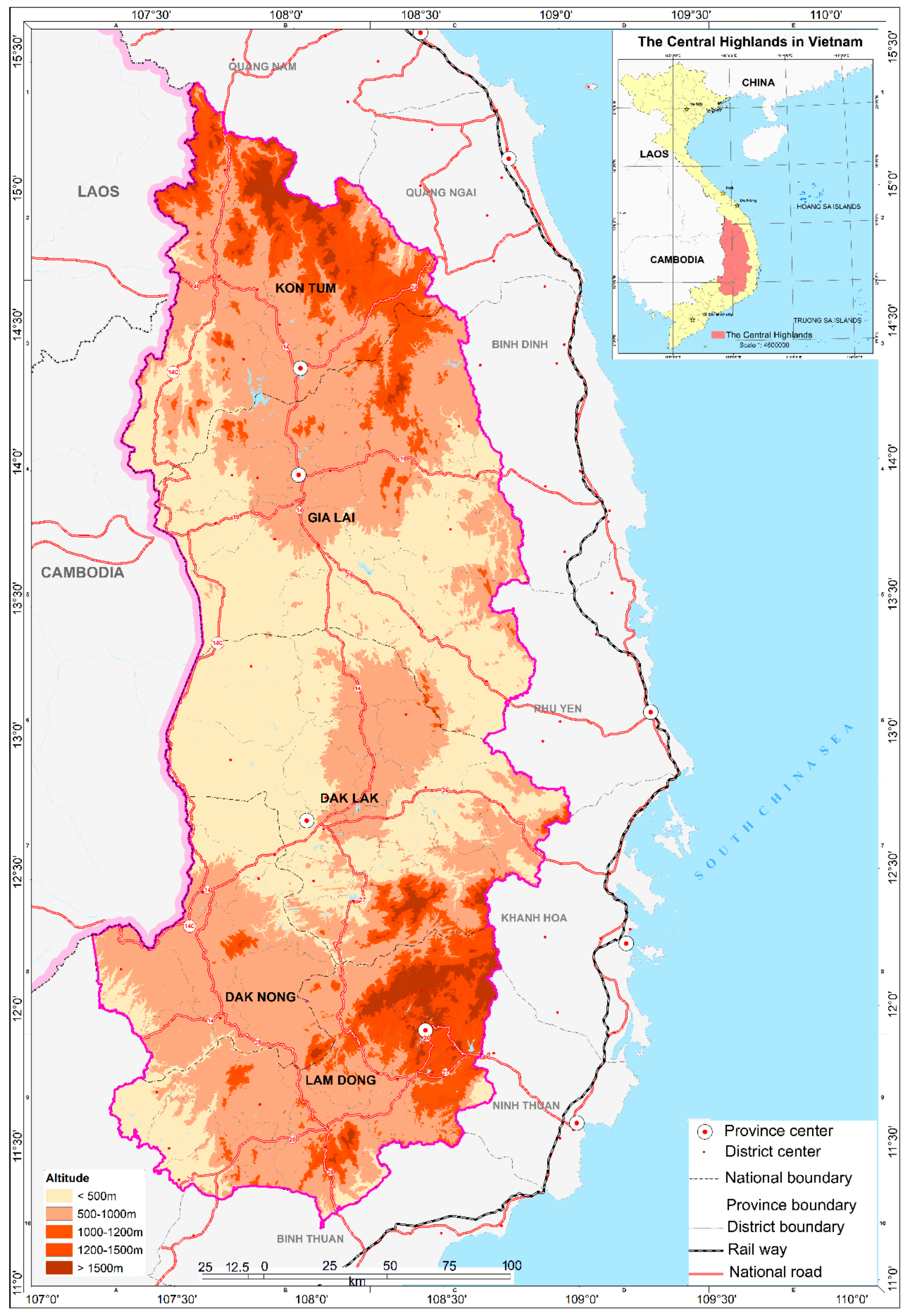
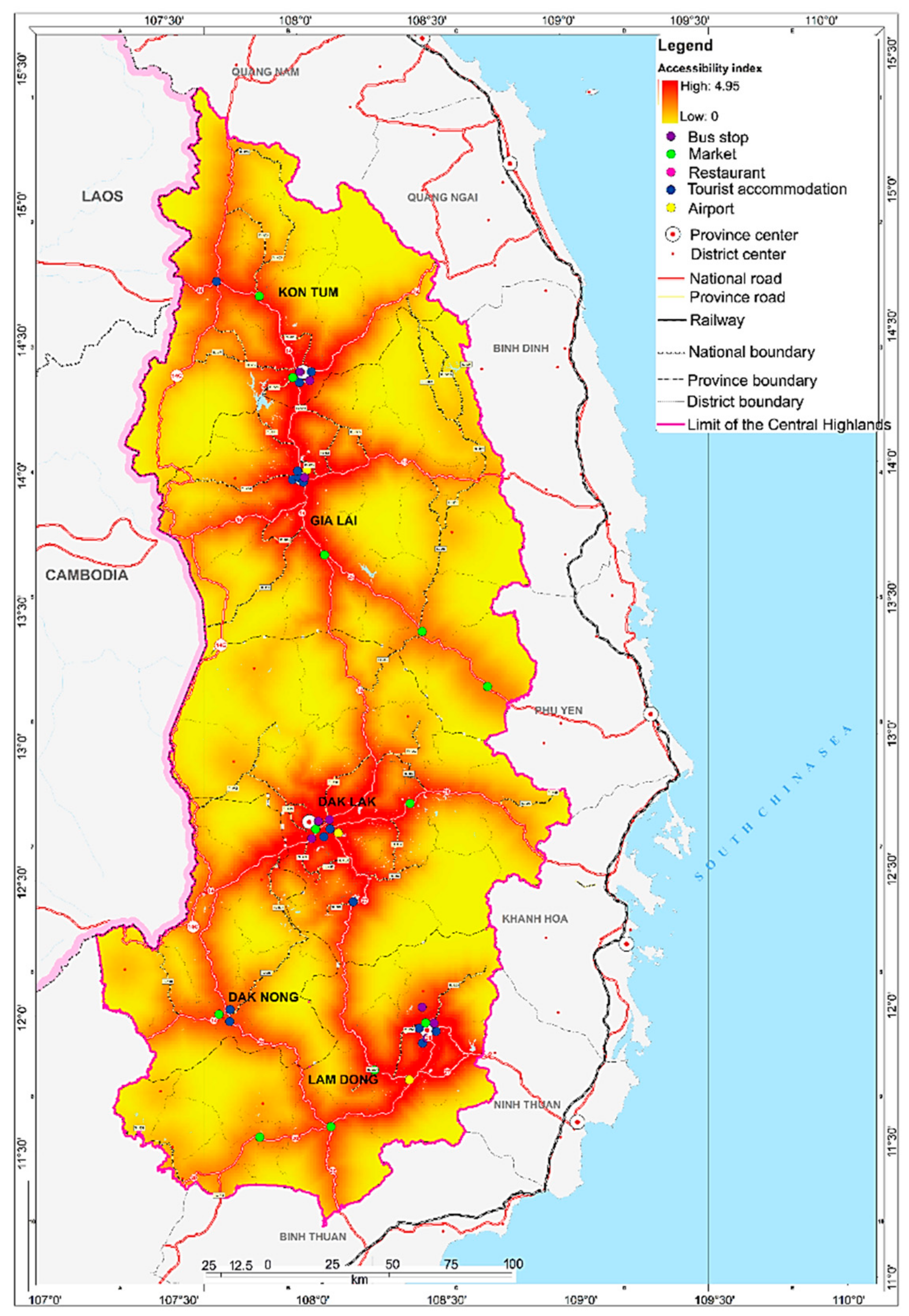
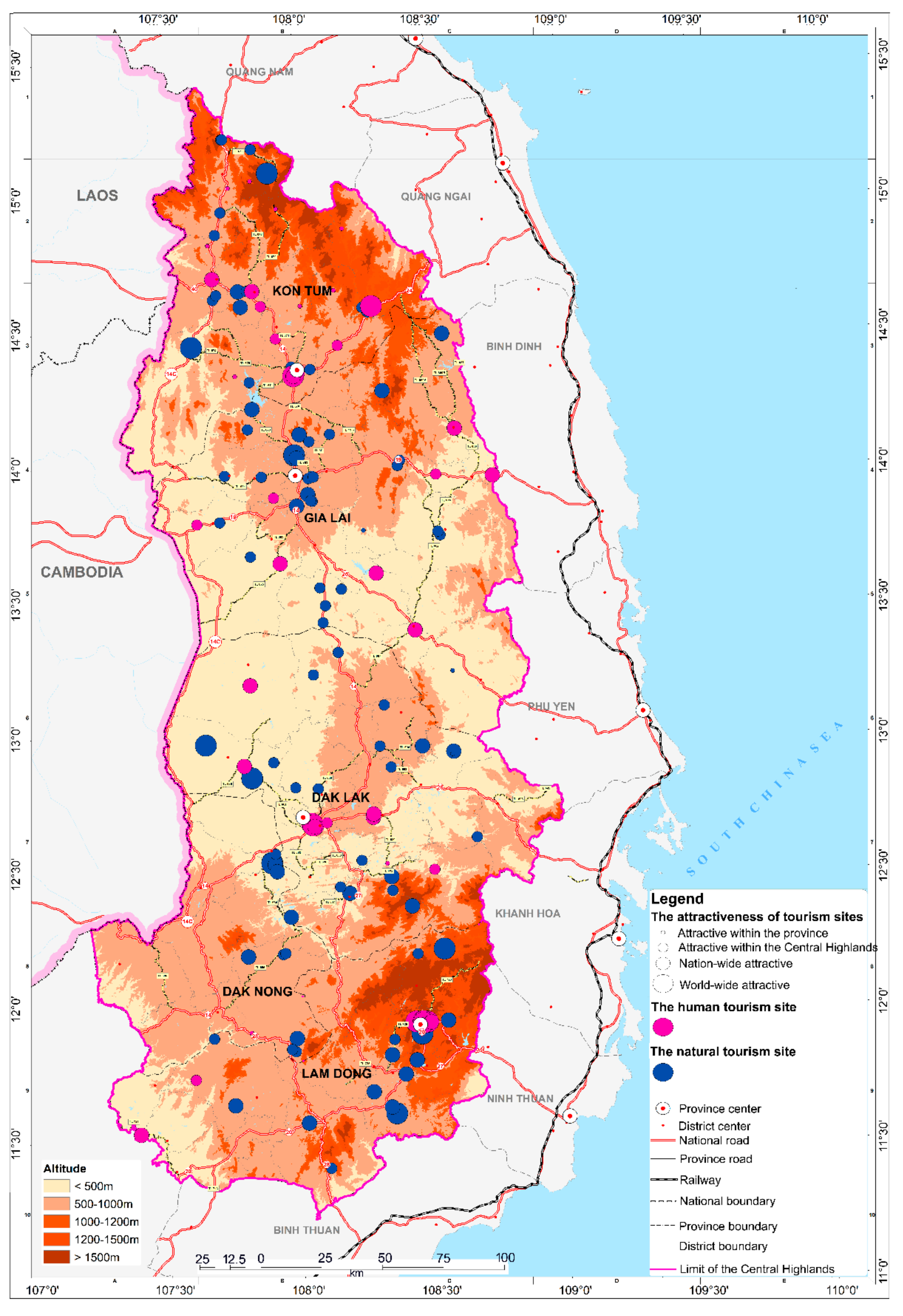
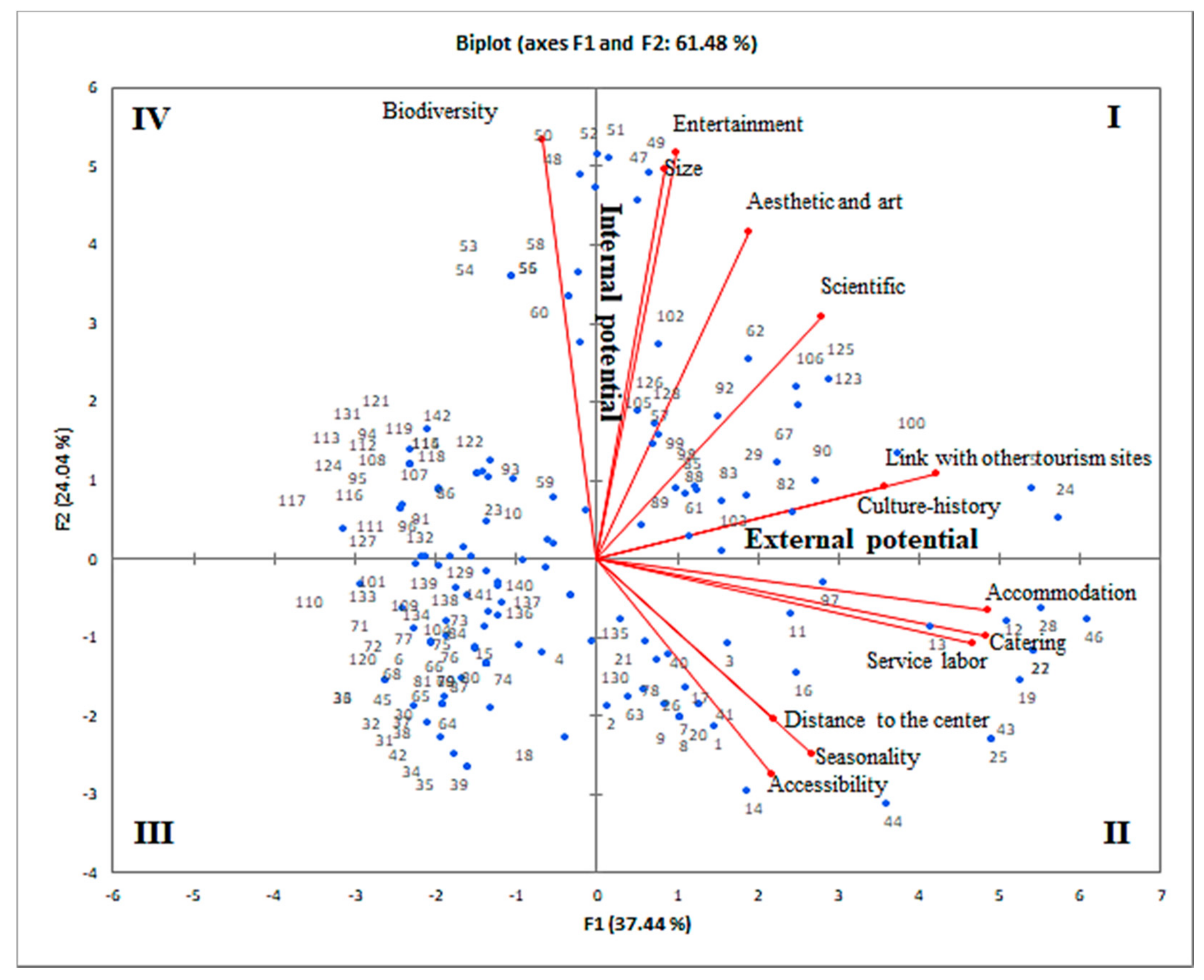
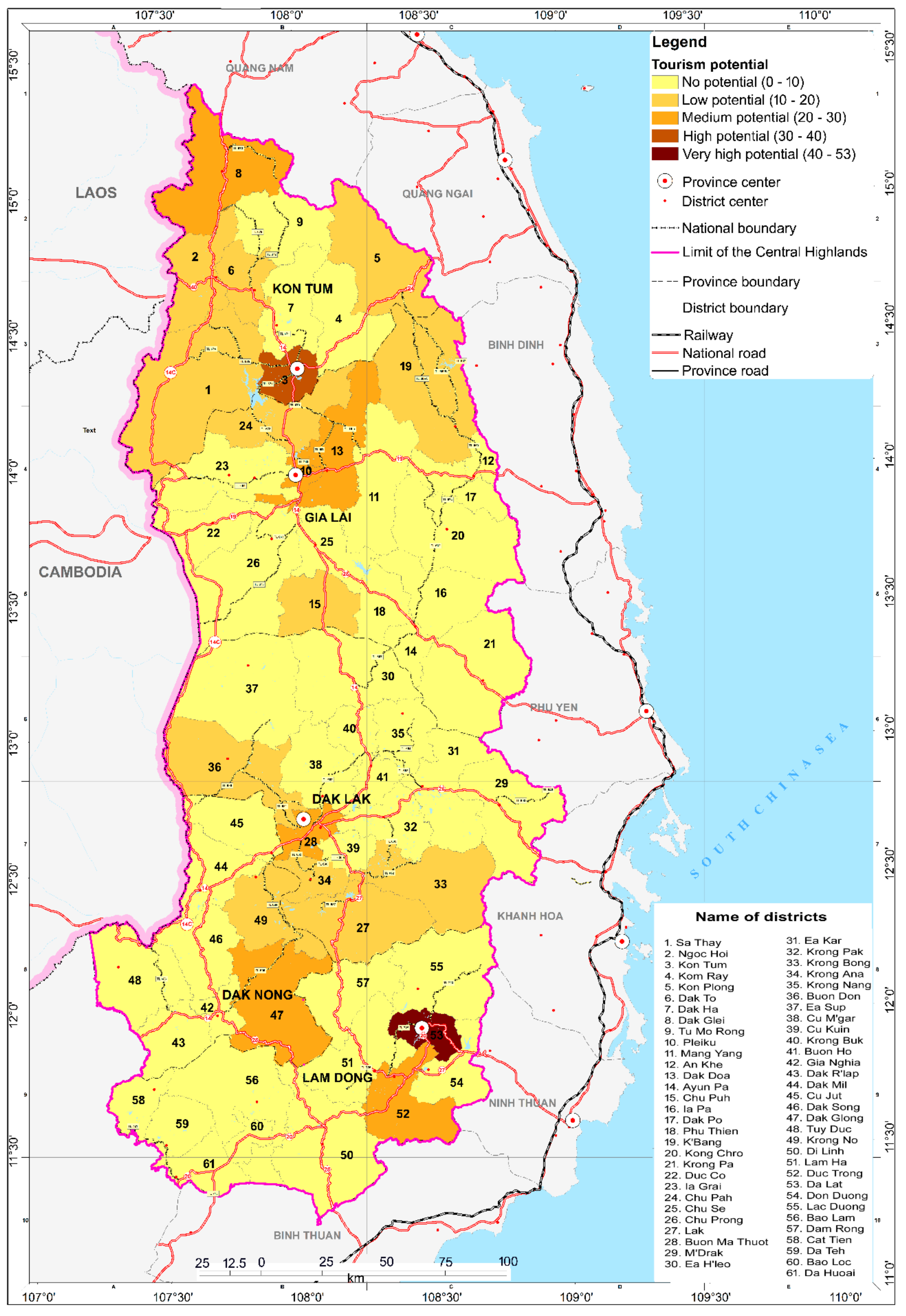
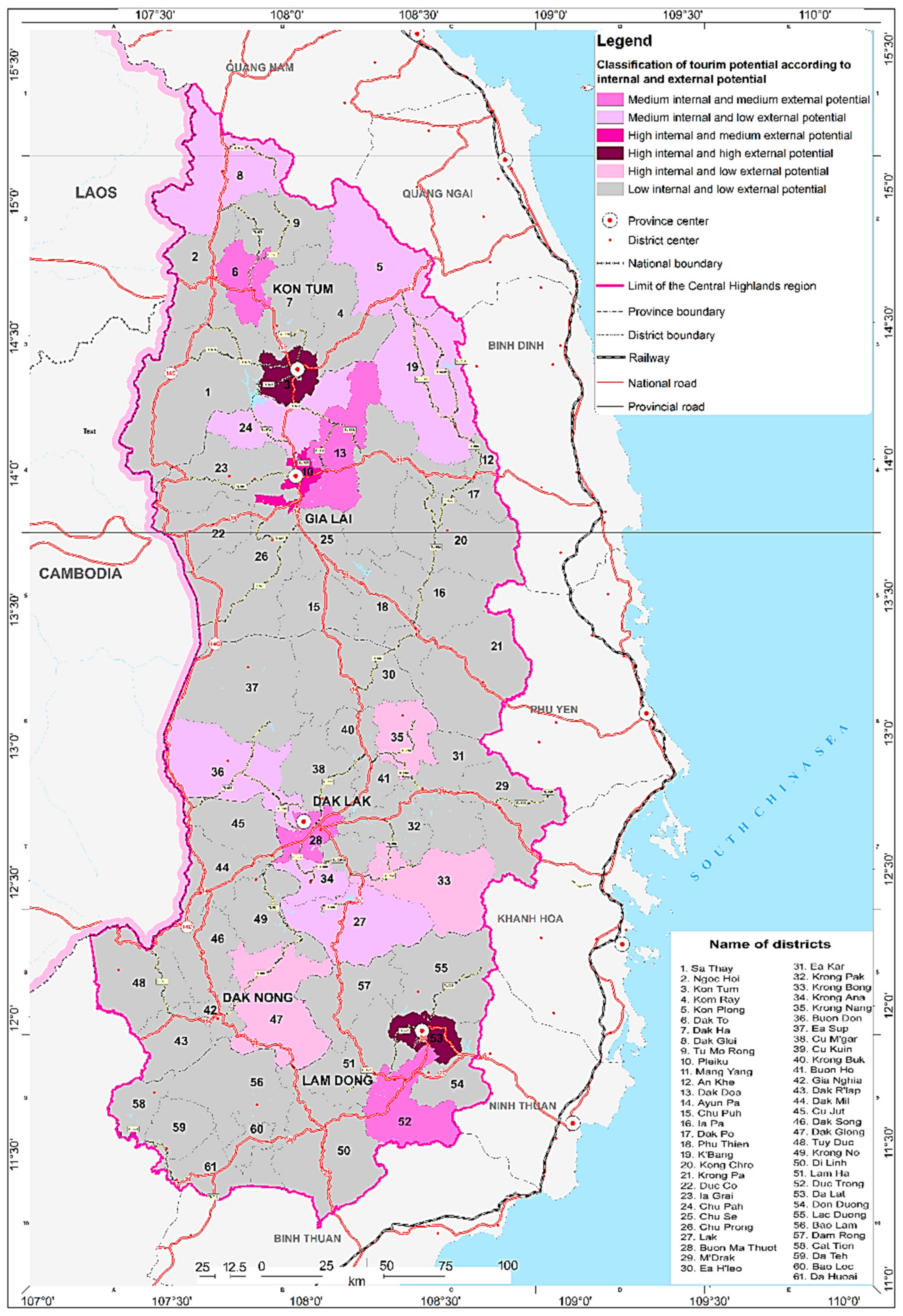
| Tourism Potential | Selected Criteria | Explanation and References | Evaluation Scale | Rating |
|---|---|---|---|---|
| Internal potential | Aesthetic and art value (AA) | Aesthetics and art deals with beauty and artistic taste. Tourism aesthetics and art are characterized into philosophical, practical and cultural attributes [6,7,8,32,33,34]. | Very high | 10 |
| High | 7 | |||
| Medium | 4 | |||
| Low | 1 | |||
| Entertainment value (EN) | From a consumer perspective, the entertainment available at a destination is probably less important than its perceived quality or uniqueness. Even more important for destination competitiveness is the degree to which the entertainment is appropriate for the destination [2,6,7,8,9,35]. | Very high | 10 | |
| High | 7 | |||
| Medium | 4 | |||
| Low | 1 | |||
| Cultural-historical value (CH) | Rating cultural, historical, and scientific value decentralized under the State ranking: province-wide, region-wide, nation-wide, and world-wide attraction [6,7,8,10,36,37]. | World-wide attractive | 10 | |
| Nation-wide attractive | 7 | |||
| Region-wide attractive | 4 | |||
| Province-wide attractive | 1 | |||
| Scientific value (SI) | World-wide attractive | 10 | ||
| Nation-wide attractive | 7 | |||
| Region-wide attractive | 4 | |||
| Province-wide attractive | 1 | |||
| Biodiversity (BI) | Biodiversity value is assessed according to the number of endemic species in protected areas [2,6]. | Very high | 10 | |
| High | 7 | |||
| Medium | 4 | |||
| Low | 1 | |||
| The size of tourism destination (TD) | The bigger the tourist destination, the higher the tourism carrying capacity [2]. | >50 ha | 10 | |
| >10–50 ha | 7 | |||
| 1–10 ha | 4 | |||
| <1 ha | 1 | |||
| Tourism seasonality (TS) | Appropriate duration for tourism activities [37]. | >300 days per year | 10 | |
| >200–300 days per year | 7 | |||
| 100–200 days per year | 4 | |||
| <100 days per year | 1 | |||
| External potential | Linkages with other tourist sites (LT) | The density of tourist sites [8]. | Very high | 10 |
| High | 7 | |||
| Medium | 4 | |||
| Low | 1 | |||
| Potential accessibility (AC) | Travel time from each tourist site to the accommodations, restaurants, markets, bus stations, and airport [38]. | >3 | 10 | |
| >2–3 | 7 | |||
| >1–2 | 4 | |||
| 0–1 | 1 | |||
| The distance from tourist attractions to the city center (DF) | The closer the city center, the higher the potential of the tourist market [4] | <20 km | 10 | |
| 20–40 km | 7 | |||
| >40–60 km | 4 | |||
| >60 km | 1 | |||
| Accommodation quality (AQ) | The quality of accommodation is graded using the star ranking of the hotels [2]. | Very good | 10 | |
| Good | 7 | |||
| Medium | 4 | |||
| Bad | 1 | |||
| Catering quality (CQ) | Catering quality and service labor quality refers to the statistical yearbooks [2,8]. | Very good | 10 | |
| Good | 7 | |||
| Service labor quality (SL) | Medium | 4 | ||
| Bad | 1 |
| Value of axy | Interpretation |
|---|---|
| 1 | x and y are equally important |
| 3 | x is slightly more important than y |
| 5 | x is more important than y |
| 7 | x is strongly more important than y |
| 9 | x is absolutely more important than y |
| n | 1 | 2 | 3 | 4 | 5 | 6 | 7 | 8 | 9 | 10 | 11 | 12 | 13 | 14 | 15 |
|---|---|---|---|---|---|---|---|---|---|---|---|---|---|---|---|
| RI | 0.00 | 0.00 | 0.58 | 0.90 | 1.12 | 1.24 | 1.32 | 1.41 | 1.45 | 1.49 | 1.51 | 1.48 | 1.56 | 1.57 | 1.59 |
| Criteria | AA | EN | CH | SI | BI | TD | TS | LT | AC | DF | AQ | CQ | SL | Weight Scores |
|---|---|---|---|---|---|---|---|---|---|---|---|---|---|---|
| Internal potential | 0.72 | |||||||||||||
| Aesthetic and art value (AA) | 1.0 | 1.9 | 0.6 | 2.5 | 3.9 | 6.0 | 5.6 | 5.0 | 3.1 | 5.4 | 3.5 | 3.0 | 4.8 | 0.13 |
| Entertainment value (EN) | 1.0 | 0.6 | 2.9 | 3.9 | 5.5 | 5.6 | 4.0 | 3.1 | 7.2 | 3.5 | 3.4 | 4.6 | 0.13 | |
| Cultural-historical value (CH) | 1.0 | 3.8 | 5.2 | 5.8 | 6.2 | 5.2 | 3.7 | 6.0 | 4.2 | 4.2 | 5.8 | 0.18 | ||
| Scientific value (SI) | 1.0 | 3.2 | 6.2 | 5.6 | 5.0 | 3.1 | 5.8 | 4.2 | 4.4 | 6.0 | 0.13 | |||
| Biodiversity (BI) | 1.0 | 4.5 | 3.9 | 2.5 | 1.4 | 3.5 | 3.6 | 3.8 | 4.8 | 0.09 | ||||
| The size of tourism destination (TD) | 1.0 | 1.3 | 0.8 | 0.6 | 2.5 | 1.5 | 1.7 | 1.1 | 0.03 | |||||
| Tourism seasonality (TS) | 1.0 | 1.3 | 1.4 | 3.9 | 1.4 | 1.1 | 0.8 | 0.03 | ||||||
| External potential | 0.28 | |||||||||||||
| Linkages with other tourist sites (LT) | 1.0 | 0.9 | 3.2 | 0.8 | 2.8 | 2.4 | 0.04 | |||||||
| Potential accessibility (AC) | 1.0 | 3.8 | 3.7 | 3.2 | 3.3 | 0.08 | ||||||||
| The distance from tourist attractions to city center (DF) | 1.0 | 0.8 | 1.3 | 1.4 | 0.03 | |||||||||
| Accommodation quality (AQ) | 1.0 | 2.0 | 1.9 | 0.05 | ||||||||||
| Catering quality (CQ) | 1.0 | 1.9 | 0.04 | |||||||||||
| Service labor quality (SL) | 1.0 | 0.03 |
| F1 | F2 | F3 | F4 | F5 | F6 | F7 | F8 | F9 | F10 | F11 | F12 | F13 | |
|---|---|---|---|---|---|---|---|---|---|---|---|---|---|
| Eigenvalue | 4.9 | 3.1 | 1.3 | 1.3 | 0.7 | 0.5 | 0.3 | 0.3 | 0.2 | 0.2 | 0.1 | 0.1 | 0.0 |
| Variability (%) | 37.5 | 24.2 | 10.2 | 10.0 | 5.1 | 3.5 | 2.6 | 2.2 | 1.7 | 1.2 | 1.1 | 0.5 | 0.2 |
| Cumulative % | 37.5 | 61.7 | 71.9 | 81.8 | 87.0 | 90.4 | 93.1 | 95.3 | 97.0 | 98.2 | 99.3 | 99.8 | 100.0 |
| Order | Name | Order | Name | Order | Name | Order | Name |
|---|---|---|---|---|---|---|---|
| 1 | Kon Tum prison | 37 | The Dak Pet victory monument | 73 | Ea Tan | 108 | Le Kim water fall |
| 2 | Dak Glei prison | 38 | Dak Sieng victory monument | 74 | Ea Ho | 109 | Lo O water fall |
| 3 | Dak To-Tan Canh victory relic | 39 | Kon Braih victory relic | 75 | Ea Drong | 110 | Suoi Tien water fall |
| 4 | Plei Kan victory relic | 40 | Serepok ferry | 76 | Ea Ba | 111 | Xung Khoeng water fall |
| 5 | Historical and scenic area of Mang Den | 41 | Ca Da temple | 77 | Dak Blao | 112 | Yang Yung water fall |
| 6 | Revolutionary base of Kon Tum People’s Committees | 42 | The cave complex of Khue Ngoc Dien | 78 | Me Linh | 113 | Ya Ma water fall |
| 7 | Vo Lam temple | 43 | Buon Ma Thuot war memorial | 79 | Chu A crater | 114 | Gou water fall |
| 8 | Trung Luong temple | 44 | 1968 Monument | 80 | Ia Bang crater | 115 | Ngam water fall |
| 9 | Bac Ai temple | 45 | Hang No victory monument | 81 | Plei Nh Prong crater | 116 | Dak R’lung water fall |
| 10 | Plei Oi village | 46 | The Wood-blocks of Nguyen reign | 82 | Plei Ku crater | 117 | Bay water fall |
| 11 | The Tay Son relic religion | 47 | Chu Mon Ray national park | 83 | Bien Ho crater | 118 | Bim Bip water fall |
| 12 | Pleiku prison | 48 | Kon Ka Kinh national park | 84 | Ha Bau crater | 119 | Dray Dlong water fall |
| 13 | The Stor resistance village | 49 | Yor Don national park | 85 | Hang Rong crater | 120 | Dray H’Yer water fall |
| 14 | The revolution of Zone 9 | 50 | Chu Yang Sin national park | 86 | Po Drang crater | 121 | Dray Kpor water fall |
| 15 | Dak Po victory relic | 51 | BiDoup-NuiBa national park | 87 | Dry crater | 122 | Thuy tien water fall |
| 16 | Victory relic of Road 7-Bo river | 52 | Ngoc Linh national park | 88 | Chu Dang Ya crater | 123 | Seven branches-water fall |
| 17 | Plei Me victory relic | 53 | Kon Cha Rang conservation area | 89 | Krong Kmar water fall | 124 | Mo water fall |
| 18 | Chu Ty victory monument | 54 | Ea So conservation area | 90 | Jraiblian water fall | 125 | Dray Nur water fall |
| 19 | Buon Ma Thuot prison | 55 | Nam Ka conservation area | 91 | Nine-floors water fall | 126 | Tan Canh Cliff of Stone |
| 20 | Cocoa plantation | 56 | Ta Dung conservation area | 92 | BoBla water fall | 127 | Pa Sy water fall |
| 21 | Dak Tuar cave | 57 | Ho Lak conservation area | 93 | Li Liang water fall | 128 | Ia Ly water fall |
| 22 | Lac Giao temple | 58 | Nam Nung conservation area | 94 | Dak Che water fall | 129 | Nhon Hoa water fall |
| 23 | Ancient Cham Tower of Yang Prong | 59 | Dak Uy conservation area | 95 | Dragon water fall | 130 | Hiep Thanh water fall |
| 24 | Bao Dai Villa | 60 | DraySap Gia Long conservation area | 96 | Dak Ke water fall | 131 | Da Che water fall |
| 25 | Da Lat children prison | 61 | Ngoc Hoi-Dak To Geological Heritage Complex | 97 | Lieng Rowoa water fall | 132 | Dak Krong fluvial terrace |
| 26 | Loc Bac relic region | 62 | KonPlong Geomorphological Heritage | 98 | Pongour seven-floors water fall | 133 | Dak Mon fluvial terrace |
| 27 | Da Lat station | 63 | Kon Tum Geomorphological Heritage | 99 | Tiger Cave water fall | 134 | Dak Xu fluvial terrace |
| 28 | Lycee Yersin school | 64 | Cu M’gra | 100 | Datanla water fall | 135 | Tan Canh fluvial terrace |
| 29 | Cat Tien holy land | 65 | Chu Black | 101 | Princess water fall | 136 | Dak Bla fluvial terrace |
| 30 | H16n revolutionary base | 66 | Duc Co | 102 | Dam B’ri water fall | 137 | Dak Cam fluvial terrace |
| 31 | Chư Tan Kra-High Point 995 | 67 | Bien Ho | 103 | Cam Ly water fall | 138 | Dak Doa fluvial terrace |
| 32 | Dak Ui resistance base | 68 | K’dang | 104 | Trinh Nu water fall | 139 | Ia Le fluvial terrace |
| 33 | Xong Dui resistance village | 69 | La Bang | 105 | Gia Long water fall | 140 | Ea H’Leo fluvial terrace |
| 34 | Kon H’ring war remnants | 70 | Ia Pet | 106 | Dray Sap water fall | 141 | Dak Xu swamp |
| 35 | Peak 601 | 71 | Dak Troi | 107 | La Nhi water fall | 142 | Erosion tower formation |
| 36 | the Mang But victory monument | 72 | Nhon Hoa |
| Group of Districts | Tourism Potential | Priority for Tourism Investment |
|---|---|---|
| Da Lat (Lam Dong province) | High internal and high external potential | Most priority for tourism investment |
| Pleiku (Gia Lai province) | High internal and medium external potential | Priority for tourism investment. Necessary investing more in infrastructure. |
| Kom Tum and Dak To (Kon Tum province), Dak Doa (Giai Lai province), Buon Ma Thuot city (Dak Lak province) and Duc Trong (Lam Dong) | Medium internal and medium external potential | Priority for tourism investment. Necessary to upgrade the tourism infrastructure, strengthen links with the other tourist sites to increase tourism attraction, and diversify tourism products. |
| Krong Nong, Krong Bong (Dak Lak province); Dak Glong (Dac Nong province) | High internal and low external tourism potential | Priority for tourism investment. Necessary to attract more tourism investment and improve the quality of tourism services. |
© 2018 by the authors. Licensee MDPI, Basel, Switzerland. This article is an open access article distributed under the terms and conditions of the Creative Commons Attribution (CC BY) license (http://creativecommons.org/licenses/by/4.0/).
Share and Cite
Hoang, H.T.T.; Truong, Q.H.; Nguyen, A.T.; Hens, L. Multicriteria Evaluation of Tourism Potential in the Central Highlands of Vietnam: Combining Geographic Information System (GIS), Analytic Hierarchy Process (AHP) and Principal Component Analysis (PCA). Sustainability 2018, 10, 3097. https://doi.org/10.3390/su10093097
Hoang HTT, Truong QH, Nguyen AT, Hens L. Multicriteria Evaluation of Tourism Potential in the Central Highlands of Vietnam: Combining Geographic Information System (GIS), Analytic Hierarchy Process (AHP) and Principal Component Analysis (PCA). Sustainability. 2018; 10(9):3097. https://doi.org/10.3390/su10093097
Chicago/Turabian StyleHoang, Huong T.T., Quang Hai Truong, An Thinh Nguyen, and Luc Hens. 2018. "Multicriteria Evaluation of Tourism Potential in the Central Highlands of Vietnam: Combining Geographic Information System (GIS), Analytic Hierarchy Process (AHP) and Principal Component Analysis (PCA)" Sustainability 10, no. 9: 3097. https://doi.org/10.3390/su10093097
APA StyleHoang, H. T. T., Truong, Q. H., Nguyen, A. T., & Hens, L. (2018). Multicriteria Evaluation of Tourism Potential in the Central Highlands of Vietnam: Combining Geographic Information System (GIS), Analytic Hierarchy Process (AHP) and Principal Component Analysis (PCA). Sustainability, 10(9), 3097. https://doi.org/10.3390/su10093097







